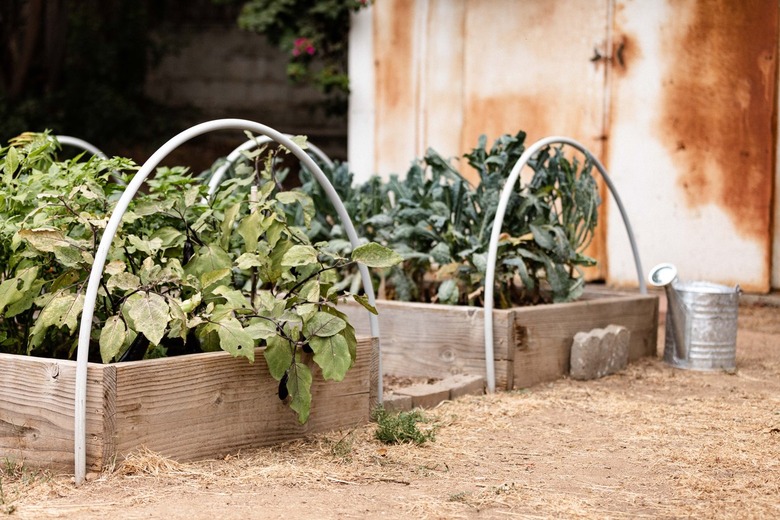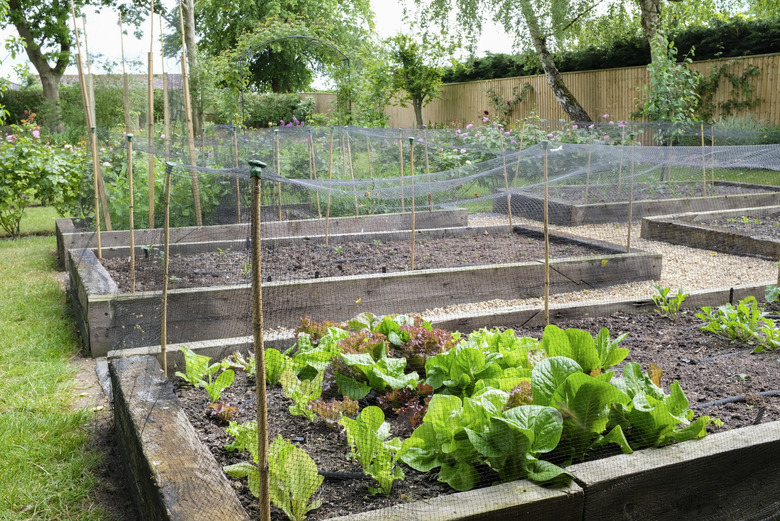9 Tips For Starting A Raised Bed Garden
We may receive a commission on purchases made from links.
If you're a city dweller with no space for an in-ground garden, a raised bed may be your only option for growing your own vegetables, but even a homesteader with an abundance of arable land can benefit by having at least one raised garden bed on the property. A raised bed is easy to maintain — no hands-and-knees weed pulling required — and because the soil stays warmer than it does in the ground, a raised bed can extend the growing season and allow you to grow plants you might not otherwise be able to grow. Raised beds are easier to pest-proof than in-ground gardens, and you'll never compact the soil by walking through the garden.
If you're new to raised-bed gardening and don't feel confident in your ability to grow quality produce or stunning flowers, start small and simple to get the feel for it. As you eventually add plants, you'll note which ones like to be together in the confined space of a garden bed and which don't, and you'll get an understanding of the individual needs of each plant. Here are nine tips for starting a raised-bed garden.
1. Pick a Sunny Spot
1. Pick a Sunny Spot
Most plants you'll want to grow in your raised bed need six to eight hours of full sun per day to thrive, so it's important to locate the bed in a sunny spot. Before you set up the bed, watch the daily movement of the sun around the yard, and once you've zeroed in on a likely candidate, consider deploying a light meter to measure the amount of daily sun in that spot. A light meter doesn't cost much, and if you buy one that also measures soil pH and moisture, you can put it to good use after the bed is filled. If you can't find a spot with full sun, there are still plenty of things you can grow, particularly leafy vegetables, like lettuce and kale, and shade-tolerant ornamentals, but the selection of veggies and flowers you can grow will be more limited.
2. Make Your Raised Bed Easy to Access
2. Make Your Raised Bed Easy to Access
Ideally, you don't want your raised bed to be any wider than 4 feet so you can easily reach plants in the middle without having to walk or kneel on the soil and compact it. To ensure access on all four sides, avoid placing the bed right next to a building, fence, or another raised bed. When placing more than one raised bed in a garden, the spacing between them should be 18 inches at a minimum, but if you're going to be using a wheelbarrow, more space is better — at least the width of the wheelbarrow plus a few inches of clearance.
3. Think About the Irrigation System
3. Think About the Irrigation System
Growing plants in raised beds is more water-intensive than growing them in the ground because the soil is warmer, and water drains more quickly in the raised beds. Depending on the climate and type of plants you're growing, you may have to water the bed daily, so it's important to consider your irrigation options before you fill the bed. You may find the idea of drip irrigation or an in-ground sprinkler system attractive, and the best time to install components is often before you add soil or while you do it but not afterward. It's also important to locate the bed near a water source, such as a spigot, especially if you plan to hand water or use soaker hoses so you don't have long hoses snaking through the yard and sitting in the sun, which deteriorates them and overheats the water inside.
4. Protect the Bottom of the Bed
4. Protect the Bottom of the Bed
Place landscape fabric on the bottom of the bed before introducing soil. It will keep out wandering tree roots attracted to the nutritious soil in the bed and will help keep weeds at bay. If there are gophers around, placing gopher wire under the landscape fabric will keep them out. If you're setting the bed on grass, on ground cover, or on a lot of weeds, layer cardboard on top of the landscape fabric. It will suffocate whatever is growing underneath it and will eventually decompose and become part of the garden soil.
5. Fill the Bed With Good Soil
5. Fill the Bed With Good Soil
The best soil for a raised bed is probably store-bought potting mix, which comes in bags, or a soil mix containing a mixture of topsoil and compost that is trucked in by a local supplier. You can also use garden soil from another part of the yard. When using native soil, you'll want to add soil amendments, such as peat moss or perlite, to improve drainage; organic matter, such as compost, to supply nutrients; and dolomitic lime if the pH, as measured by the combination meter you bought to test for light, is below 6.0. It's a good idea to mix the soil in a wheelbarrow before putting it in the bed, and to ensure even moisture, fill the bed in 6-inch layers and soak each layer thoroughly before adding the next.
6. Plan a Weed-Control Strategy
6. Plan a Weed-Control Strategy
Weeds are inevitable, and there are two schools of thought when it comes to controlling weeds in a raised bed. One way to do it is to simply scatter seeds throughout the bed and thin plants as needed when they emerge. This typically results in dense growth that prevents weed seeds from sprouting, and it works well if you're growing a collection of native plants and wildflowers. Another method that is more appropriate for a vegetable garden is to sow seeds in well-defined rows. This makes weed identification easier since anything growing in a part of the garden where you know you haven't planted anything must be a weed, and weeding is also easier because you can do it with a hand weeder.
7. Devise a Suitable Layout
7. Devise a Suitable Layout
A raised bed has limited growing space, and if you want to grow more than one type of flower or vegetable, you need a layout. A common strategy for planning the layout is to divide the garden area into a grid with sections each measuring 1 square foot and devote each section to a particular type of plant. You might put low-growing flowers or low-growing vegetables, such as lettuce or radishes, on the outside rows and taller ones, such as tomatoes, in the middle. You can also cram tons of herbs and veggies that grow in small spaces, such as chives and basil, as well as some edible flowers, like nasturtium, on one end of the bed and put a trellis on the other end to support tomatoes, squash and other edibles that need more space.
8. Group Compatible Plants
8. Group Compatible Plants
Different plants have different watering needs, and you don't want to put a plant that needs a lot of water next to one that doesn't need as much because only one will thrive. Besides knowing the watering and fertilizing needs of the plants you put in your garden, you also have to know which ones get along and which ones don't. Beans and tomatoes are famously incompatible.
Despite this antagonism, there are many examples of companion plants that benefit each other. Perhaps the best-known example of companion planting is the "three sisters" — corn, beans, and squash — which Native Americans always planted together because they grow better as a team than they do individually.
9. Keep Beds Moist and Well Fertilized
9. Keep Beds Moist and Well Fertilized
Because soil in a raised bed tends to dry out quickly, it's tempting to water every day — and you may have to do that — but you should water only when the top 2 inches of topsoil has dried out. If you use mulch liberally in the garden, the soil won't dry out as quickly. At the beginning, it's a good idea to water by hand so you get an idea of how frequently the garden needs water, but once you've determined that, it's usually more convenient to set up an automatic irrigation system on a timer. This is easy to do if you've installed drip irrigation or a sprinkler system, but if not, you can do it by connecting a soaker hose to a timer connected to the nearest spigot.
Use a store-bought testing kit or take a soil sample to your local Cooperative Extension Service to have the soil tested a few times during the growing season, and add nutrients as needed. It's a good idea to maintain a compost pile near the garden so you have a ready supply of organic matter to work into the soil, but if you don't have compost, you can use chicken manure, fish emulsion, or a commercial organic fertilizer.

